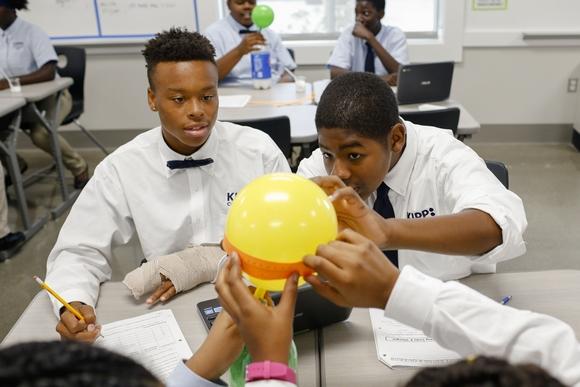Expanding KIPP Columbus charter school opens new high school
ByShannon Gilchrist
Read the full article at Dispatch.com >
From 50 students to nearly 1,400 — a charter school has expanded its reach in a disadvantaged Columbus neighborhood by 27-fold over nine years.
The Knowledge is Power Program, which started out in Columbus in 2008 with 50 fifth-graders in an old elementary school in Linden, opened a new high school building on Aug. 17 to add to its elementary and middle schools.
By 2020, KIPP Columbus estimates it will gain another 600 students, bringing enrollment near 2,000.
Now, early in its 10th year, gleaming school buildings sit on 124 rolling acres of a former golf course off Agler Road on the Northeast Side that the school purchased in 2013. The road that runs through campus, Inspire Drive, is protected by a guard stand and gates. The buildings’ corridors and lobbies are lined with inspirational quotes from famous Ohioans.
Executive Director Hannah Powell pointed out a particular favorite from astronaut and U.S. Sen. John Glenn in one hallway: “We are more fulfilled when we are involved in something bigger than ourselves.”
“We’ve designed (the buildings) to match our kids’ potential and aspirations,” said Powell, who has been with the school since halfway through the first year. “We are unabashed in our belief that they deserve this.”
KIPP is part of a nationwide network of charter schools that focus on character and on turning students’ expectations toward attending college.
“We demand a lot from them,” said Abigail Wexner, a longtime KIPP Columbus board member who just joined the national board. “But we know they can do it.”
The high school serves ninth and 10th grades this year. The right side of the building is known as the production zone, where math and science is the focus. The center is the contemplative zone, where English and the humanities are taught. The active zone on the left side features a studio for yoga and dance, a weight room, a black-box theater and a giant gallery that is waiting to display student art.
On Wednesday, the school cut the ribbon on the Battelle Environmental Center, a huge life science lab built using a $3 million grant from Battelle. The company also announced at the event that it would give another $1 million for expanded programming so kids and teachers from outside of KIPP can participate year-round.
Some programs will be run by the PAST Foundation, a local nonprofit that does educational programming. The plans are for the kids to conduct an ecosystem audit of the campus, which has a natural wetland, and to map its features with drones.
“The superstar KIPP schools all have something that they’re best at,” Wexner said, and environmental science could become that focus here.
Any child can attend KIPP for free, but every grade has a waiting list and students get in through a lottery system. The school gives enrollment priority to children who live in the Columbus City Schools district and to those whose siblings already attend. Once a youngster gets into KIPP, they don’t have to reapply.
KIPP Columbus doesn’t have the best grades on its state report card, earning a D in 2015-16 for students’ performance on state standardized tests. Compared with charter schools statewide, the school ranks in the top 25 percent for its test scores.
Powell said kids often arrive at KIPP significantly behind grade level. KIPP earned an A for overall “value added” in 2015-16, meaning that students advanced far more than a year’s worth of learning during the school year. And on the NWEA MAP, a nationally normed set of tests, KIPP Columbus students achieved 1 1/2 times the average student learning growth.
The school tracks students after they leave KIPP for other high schools and college. Powell said KIPP alumni nationwide have double the graduation rate of other low-income schoolchildren, and they graduate from college at four times the national average for low-income students.
Kiah Fleming, 16, was taking a math test online Thursday morning covering the multiplication of trinomials and polynomials. Before she came to KIPP in the eighth grade, she had problems with truancy and chronic absences.
“I felt we were just there and just getting work to pass the time,” Fleming said. “They told me when I got here to leave the person that you thought you were behind. Here, we’re one team, one family. … Some people don’t have that kind of connection at home.”
The 10th-grader stopped mid-thought, hugged Powell and said: “This girl right here, I just love her so much.”
